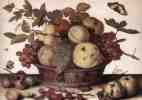![]()
 Basket of Fruits
Basket of Fruits
c. 1632; Oil on wood, 14.3 x 20 cm; Staatliche Museen, Berlin, Germany
Typically, Italian and French fruit still-lifes in the 17th century tend towards a strictly objective description of the actual phenomena. The Dutch, on the other hand, were still in the tradition of "disguised symbolism" (Erwin Panofsky) as something that gave depth to empirical precision. Balthasar van der Ast's Fruit Basket, for example, contains enough additional elements to show that he is concerned with more than a realistic rendering.
The vanitas theme is emphasized by the presence of bruises, bad spots and wormholes, as well as insects such as butterflies, dragonflies and house flies, as well as a lizard - a rather unusual sight on a table - which is nibbling at one of the apples outside the basket. Grapes of course, often has a christological reference. If we consider further that, in the context of Virgin Mary, apples symbolize redemption and victory over sin, whereas insects and lizards were often associated with the principle of evil, then this harmless everyday motif suddenly turns into a scene (though on a smaller scale) of good versus evil in the history of salvation.